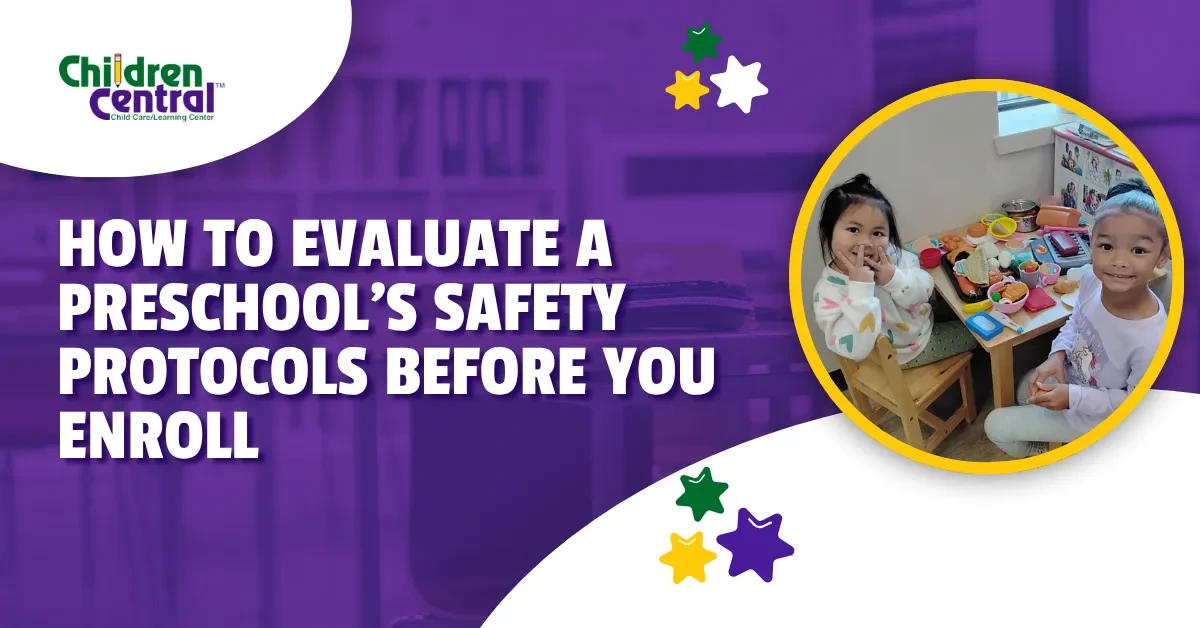 A preschool safety checklist in Langhorne, PA, gives families a clear way to evaluate a center’s protocols before enrollment. This overview helps you confirm that daily routines, facilities, and staff practices meet high standards for child well-being. Key areas include secure entry and dismissal procedures, staff training and background checks, emergency preparedness, and age-appropriate classroom and playground design.
A preschool safety checklist in Langhorne, PA, gives families a clear way to evaluate a center’s protocols before enrollment. This overview helps you confirm that daily routines, facilities, and staff practices meet high standards for child well-being. Key areas include secure entry and dismissal procedures, staff training and background checks, emergency preparedness, and age-appropriate classroom and playground design.
Attention to cleanliness, medication handling, allergy management, and illness policies supports a healthy environment. Precise ratios, active supervision, and documented incident reporting demonstrate accountability. Reviewing these elements in a structured manner allows you to compare programs confidently and choose a setting that protects every child’s safety and development.
Navigating Daycare Safety Standards in PA

A clear understanding of daycare safety standards in PA helps families evaluate whether daily practices align with state requirements and best-practice guidelines. This section will review how licensing, staffing, environment, and health protocols work together to create a consistent safety culture. The goal is to verify written policies and observe real implementation during tours.
Regulatory Foundations
The Pennsylvania Department of Human Services (DHS) licenses child care centers and publishes inspection findings. Confirm an active license, visible postings, and recent inspection summaries. Participation in Keystone STARS indicates quality improvement beyond minimums, including staff development, family engagement, and continuous safety review.
People and Preparedness
Safety is anchored in staffing. Verify completed background clearances, orientation, and ongoing professional development. Ask for current pediatric first aid/CPR certifications, mandated reporter training, and procedures for medication administration and allergy response. Ensure substitute coverage and break schedules preserve supervision at all times.
Environment and Supervision
Safe design enables effective oversight. Look for unobstructed sightlines, secured storage for chemicals and tools, anchored furnishings, and age-appropriate materials. Outdoor areas should be fully fenced, cushioned, and inspected on a defined schedule. Ratios must match age groups and be posted; attendance should be tracked in real time, with floaters supporting transitions and restroom breaks.
Health Protocols and Emergency Readiness
Review written policies for illness exclusion, handwashing, cleaning routines, diapering/toileting, and sanitation logs. Confirm labeled, locked medication storage; documented administration; and EPI-PEN accessibility. Emergency plans should outline evacuation routes, shelter-in-place procedures, drill frequency, reunification steps, and multi-channel family communication.
Quick Checks During a Tour
- License displayed and inspection reports available.
- Ratios posted; live attendance records maintained.
- Fenced playground with resilient surfacing and an inspection log.
- Locked chemical/medication storage; labeled first-aid kits.
- Documented drills, incident reports, and corrective actions.
- Clean, well-ventilated classrooms with clear sightlines.
Documentation and Transparency
Request the parent handbook, discipline policy, safety forms, and emergency communications plan. Confirm how updates are shared and how concerns are documented and resolved. Programs that provide timely records, welcome observations, and demonstrate follow-through show a durable, family-centered approach to safety.
What To Ask Preschool About Security: Entry, Monitoring, Response

A clear security plan safeguards daily routines and urgent situations alike. During your tour, request written policies and observe how procedures operate in real time. Focus on three pillars: controlled entry, continuous monitoring, and timely, well-documented response.
Entry Controls and Visitor Management
Ask how the building remains secured during program hours. Confirm locked exterior doors, video intercoms, or keypad/badge systems, and how access codes are issued, stored, and rotated. In the student file, clarify identity verification at arrival: government-issued ID checks, authorized pickup lists, and photo records. For a quick screen, look for:
- Controlled access points: single main entrance, staff-managed buzz-in.
- Pickup verification: matching IDs to authorized lists; no exceptions.
- Visitor protocols: sign-in logs, visible badges, escorted movement.
Request the written policy for contractors or therapists entering the building and how they are supervised on-site. Review dismissal procedures, late pickup protocols, and custody documentation to ensure only approved adults can sign a child out.
Monitoring Practices: People, Spaces, and Records
Effective monitoring combines trained staff, clear sightlines, and tools with privacy in mind. Ask whether cameras cover entrances, hallways, and playgrounds; who reviews recordings; how long footage is retained; and how access is controlled. Inside classrooms, confirm posted ratios, active supervision zones, and real-time attendance during transitions. Prioritize evidence of routine checks:
- Camera policy essentials: coverage map, retention timeline, access controls.
- Supervision essentials: documented headcounts, door alarms, perimeter sweeps.
Verify that inspections are logged and safety issues trigger same-day corrective action. Confirm the process for anonymously reporting concerns and how leadership reviews trends.
Response Procedures: Drills, Communication, and Documentation
Request the emergency operations plan for evacuation, shelter-in-place, medical emergencies, severe weather, and intruder scenarios. Ask about drill frequency, staff role assignments (lead, runner, reunification), and how substitute teachers are briefed. Ensure communication is multi-channel and redundant—text, email, and phone—until all children are released. Key response components to look for include:
- Reunification details: off-site location, parent ID checks, and release logs.
- Documentation practices: same-day incident reports, root-cause analysis, corrective actions.
Confirm collaboration with local first responders and periodic tabletop exercises with staff.
Tour-Day Questions to Guide Your Evaluation
- How are access codes managed, rotated, and revoked?
- Which areas are under camera coverage, and who can view footage?
- How often are drills conducted, and how are results reviewed?
- What is the reunification site if off-site evacuation is needed?
- How are security incidents documented, audited, and communicated to families?
A program that answers these questions clearly shows a reliable culture of safety.
Child Care Center Safety Features That Matter: Classrooms to Playgrounds
A safe learning environment is built from many small details working together. During a tour, observe how the center’s physical design, materials, and routines reduce risk while supporting active exploration.
Classroom Layout and Materials
Thoughtful classroom design improves supervision and prevents accidents. Look for low, open shelving that keeps materials visible; anchored bookcases and tall furniture; and clear pathways that minimize tripping hazards. Electrical outlets should be covered, window cords secured, and doors equipped with finger guards.
Age-appropriate materials must be intact, nontoxic, and stored at child height to limit climbing. Ventilation and indoor air quality matter—ask about HVAC filters, fresh-air exchange, and daily cleaning schedules.
Quick checks:
- Anchored furniture and cushioned corners in busy areas.
- Labeled and locked storage for cleaning supplies and medications.
- Emergency exits are clearly marked, unobstructed, and routinely tested.
Bathroom, Handwashing, and Sanitation
Hygiene features protect health. Restrooms should be close to classrooms, with child-height sinks, touchless dispensers, and posted handwashing steps. Diapering areas require a hands-free lidded trash can, single-use liners, and a sink within arm’s reach. Confirm daily sanitation logs for high-touch surfaces, toys, and cots, and ask how illness outbreaks prompt increased cleaning.
Ask to see:
- Written cleaning schedules and product safety data sheets.
- Procedures for separating sick children until pickup.
Entrances, Hallways, and Common Spaces
Shared spaces should support controlled movement and supervision. Entrances need secure vestibules, visitor badges, and staff sightlines to the front door. Hallways benefit from convex mirrors, door alarms, and posted capacity limits for multipurpose rooms. First-aid kits and AEDs should be visible, stocked, and checked on a set cadence.
Look for evidence of:
- Regular safety inspections with corrective action notes.
- Clear signage for evacuation routes and shelter areas.
Playground Design, Surfacing, and Outdoor Procedures
Outdoor areas require fencing, self-closing gates, and zones that separate toddlers from older children. Equipment must be age-rated, well-maintained, and spaced to prevent collisions. Impact-absorbing surfacing, such as engineered wood fiber, rubber tiles, or poured-in-place, should be deep or thick enough under fall zones, with drainage to prevent pooling. Shade structures, water stations, and slide temperature checks reduce heat risks.
Essential outdoor practices:
- Pre-play inspections, documented head counts, and defined teacher zones.
- Weather policies for air quality, heat, lightning, and icy conditions.
When these features are present and consistently maintained, classrooms and playgrounds function as safe, purposeful spaces that support children’s growth every day.
Health Readiness and Emergency Planning: Training, Drills, Communication
Proactive health readiness and clear emergency planning protect daily routines and high-stress moments. Families should confirm that staff preparation, drill execution, and target=_”blank” multi-channel communication are reliable, supported by written policies and consistent documentation.
Staff Training and Medical Readiness
A strong program invests in role-specific training and refreshers. Verify current pediatric first aid and CPR certifications for all classroom staff, with renewal dates tracked by administration. Ask about mandated reporter training, medication administration procedures, and EPI-PEN/AED practice. Clarify how substitutes are briefed before entering a classroom and how health plans for allergies, asthma, seizures, or diabetes are shared across teams.
Request evidence of:
- A training matrix with completion dates and renewal timelines.
- Individual health plans, signed by families and physicians, are stored in classrooms and the office.
- Readiness checks for first-aid kits, AED pads, and emergency medications.
Emergency Plans and Drill Cadence
The emergency operations plan should cover evacuation, shelter-in-place, severe weather, medical emergencies, utility failures, and intruder scenarios. Roles must be defined—incident lead, attendance runner, reunification lead—and practiced on a predictable schedule. Drill logs should include date, time, scenario, duration, challenges observed, and corrective actions.
During your tour, ask:
- How often does each drill type occur, and how are the results reviewed with staff?
- Where off-site reunification occurs and how parent IDs are verified.
- How infants and toddlers are transported during evacuations (cribs, wagons, or evacuation devices).
Communication Systems and Family Coordination
Effective communication is redundant and accessible. Confirm the primary notification platform (family app, SMS, email) and how messages escalate if a parent does not respond. Staff should maintain printed emergency cards alongside digital records to address power or network outages. Look for posted communication ladders and templates for urgent alerts, closures, or health notices.
Core elements to verify:
- Multi-channel alerts with time-stamped delivery records.
- Classroom and office contact lists are updated each term.
- Intercom or two-way radios for sitewide coordination.
Documentation and Continuous Improvement
Strong programs analyze every incident for prevention. Review how accident and illness reports are completed, signed, and shared the same day. Ask how trends inform training, room setup, or staffing adjustments. Routine after-action reviews, transparent policy updates, and family feedback loops indicate a mature culture of safety grounded in continuous improvement.
Conclusion
A careful review of entry controls, monitoring practices, classroom design, health protocols, and emergency planning gives families the clarity they need to make an informed decision. Using a preschool safety checklist in Langhorne, PA, ensures each program is measured against consistent standards—from staff training and supervision to playground maintenance and communication systems. Strong centers welcome questions, provide documentation, and demonstrate procedures in real time. When a school pairs transparent policies with sustained follow-through, children benefit from safe, predictable routines that support learning and well-being.
Ready to discuss safety practices and schedule a visit? Call (215) 398-1076 or visit https://childrencentral.net/contact-children-central/.



